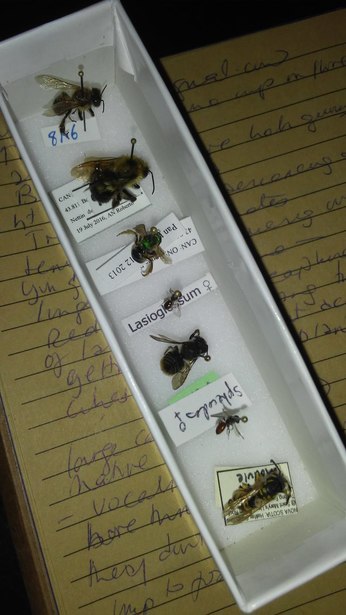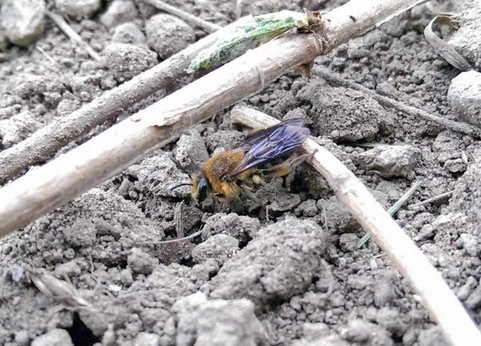 Bees: Samples Bees: Samples Scott MacIvor makes me want to care for wild bees. I mean really care. In his April 9th lecture--entitled Wild-bee Diversity and Pollination Services: Are Cities a Refuge?--given at RBG for the Hamilton Naturalists' Club, Scott who is a bee expert and an Assistant Professor at the University of Toronto Scarborough in the Department of Biological Sciences, spoke about the specific needs of wild bees of our cities. Scott's tender love of bees was contagious as he described the lives of these industrious little creatures apart from ours, doing their bee thing; their relationships--they have beautiful, complicated and unique relationships!--with their own special flowers. The poetry of it all: how flowers have evolved nectar, scent and oil essence because they are trying to attract their favourite bees. Bees are positively charged while pollen is negatively charged. There's this technique used by some bees called "buzz pollination" or sonication, to release pollen which is firmly held by the anthers that is a fast, effective, interaction with the flower in point. And only bigger bees can open certain kinds of flowers. "Bees and flowers communicate with each other," Scott said. Some bees, like the Carpenter bee, will vocalize to flight. "And for each flower, there is a different suite of bees, that is, flowers have a community of bees that they prefer." "In the same way, different bees have different affinities for flowers, different interactions scaffolding one another. There's a mutualism in action." Think of that! Most wild bees are solitary-- they live on their own. Female bees work to exhaustion, work to death, males mate and die. Yep. Sounds about right. What's more, each female is her own queen. I like that a lot. Some other interesting facts that Scott shared: Bees are more related to their sisters than to their offspring. Wild solitary bees are active only for a few weeks in the year, adults are very short-lived, one generation per year. "They have evolved to be active for their favourite flowers," Scott said. "They go find that beautiful dark cavity to build their rooms, all the males in the front, to die, all the females in the back because they are more important. Imagine a mason bee, waiting in a grass stem waiting, waiting for that one cue: warmth." With his presentation, Scott invited us, we people of the Golden Horseshoe, to plan our spaces for solitary wild bees. His lecture was an invitation to consider how our designs, here in the city, might influence our decision making for supporting bee diversity. Look down. There's a whole world you're missing. From "Bees of Toronto." From "Bees of Toronto." We humans walk around with our heads in the air, we don't look at the ground much (unless you are a gardener or such). But here's the thing--90% of the 360 native bee species of this region live and nest in the ground. There is an entire world of bee activity going on, right under our noses. Protecting Wild Bees That same night that Scott gave his presentation, the City of Toronto agreed to the Pollinator Protection Strategy (Scott helped develop this too), when it went to council that very day. As Scott pointed out, most bees in cities are native to the region because bees tend to stay put. As well, "We find new species to science, right on the corner of Bathurst and College and also, global warming is causing bees to come up here," Scott said. Of course, wild bees need wildflowers, both remnant and restored sorts, so it is critical to maintain the stability of these native plants. And with more areas conserved, there will be more species conserved. Which is important for biodiversity, on which many of our food sources depend on. To this end, Scott talked about the link between wild bees and food security. It is known that pollination is improved with bee diversity--that is, the diversity of bees visiting crops. With foods like squash and watermelon, Scott estimated that there is a 2000 pollen grain exchange happening on a flower, "so you need to have a big bee to move this pollen." He pointed out that the number of bee species is important. Different bees buzz differently, they touch the flowers differently. The bottom line: "We can not just go and buy 100,000 wild bees the way we can honeybees. But we are losing wild bees species and today we have half as many species then we did almost 100 years ago." Take the sweet little rusty-patch bumble bee, which is no longer common (there is a recovery strategy to bring it back). And here we are, in one of the most bee-diverse regions in Canada! Bees' Needs From "Bees of Toronto." From "Bees of Toronto." Bees need more than flowers and trees, but "cities are constantly threatening their ground," Scott said. He pointed to the need for sandy, non compacted soil--soil that is not covered in plants, but rather, ground with bare, open soils (he loves Hyde Park for its Oak Savannah fragments). Remember that we are talking about "microhabitats" that different species are using. Ideally, there will be different sands and soils that are "compelling and interesting." Stay away from mulch (mulch is not good for bees, Scott advises, which is found often around tree pads--that's where bees are nesting). Other tips include keeping the wood thicket at the edge of the garden, rather than cutting all that and mulching. Provide a rock wall and or mound or hill. It's valuable to place a rock in a southeast direction, in the sun. Wild bees can replenish and conserve their energy in full sun because, "We don't want to waste their energy, they are already tired," Scott said. .As well, understand that wild bees require nesting materials like resin, pinesaps, pebbles, seeds, and leaves. **** Bees find refuge in cities. Scott's research explores whether it's because of a novel erroneous mistake or is it that bees are adapting to our cities? Are they"urban loving" because cities are warmer, to cities have more gardens, or that there's not much use of pesticides? Leaf-cutter bees are using shopping bags and window caulking. Large carpenter bees bore through wood decks, for example, they don't nest in nature. Cavity-nesting bees are innovative, making their nests in artificial designs that mimic natural cavities like dead wood, ("drilled by beetles and occupied by bees"): a tire rim, a metal armchair. The point is, there seems to be many generalists but few specialist bees, so we need to scale up our gardens to enact change in favour of more of the later. ** Check out Bev Wagar's article about the same lecture over at the Hamilton Monarch Awards website! Great piece Bev!
3 Comments
11/8/2019 04:28:57 pm
Bees are really in a tight spot at this moment in time. I know that most of us do not value them that much, and that is the problem. Once we begin to go and think about how we are going to handle their impending doom, then we will become better people. They are part of the ecosystem that we live in. Our ecology is an intricate one, a little change will cause a ripple of effect that can change our lives.
Reply
3/27/2023 08:47:35 am
Thanks for sharing this information. Keep us updated!
Reply
Leave a Reply. |
Archives
December 2023
Categories |
|
|
Butterflyway Hamilton: www.facebook.com/butterflywayhamilton/
Environment Hamilton: https://www.environmenthamilton.org/ Hamilton Naturalists' Club: https://hamiltonnature.org/ |

 RSS Feed
RSS Feed